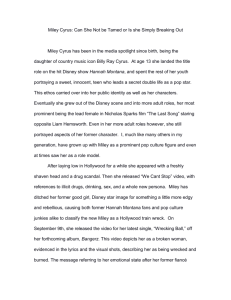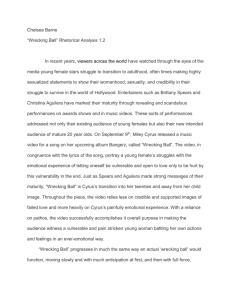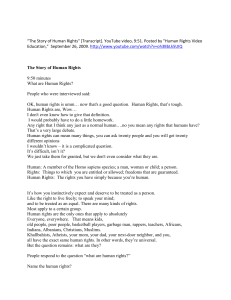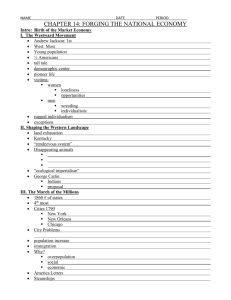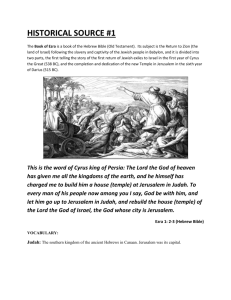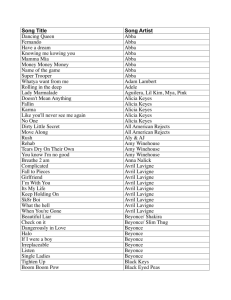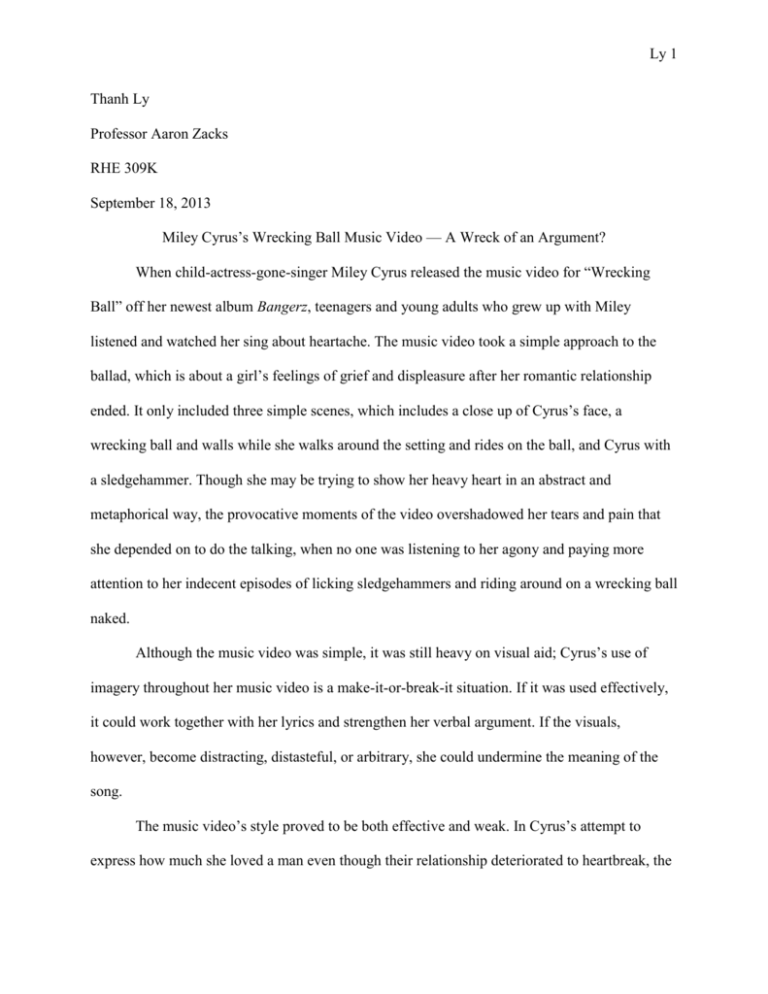
Ly 1
Thanh Ly
Professor Aaron Zacks
RHE 309K
September 18, 2013
Miley Cyrus’s Wrecking Ball Music Video — A Wreck of an Argument?
When child-actress-gone-singer Miley Cyrus released the music video for “Wrecking
Ball” off her newest album Bangerz, teenagers and young adults who grew up with Miley
listened and watched her sing about heartache. The music video took a simple approach to the
ballad, which is about a girl’s feelings of grief and displeasure after her romantic relationship
ended. It only included three simple scenes, which includes a close up of Cyrus’s face, a
wrecking ball and walls while she walks around the setting and rides on the ball, and Cyrus with
a sledgehammer. Though she may be trying to show her heavy heart in an abstract and
metaphorical way, the provocative moments of the video overshadowed her tears and pain that
she depended on to do the talking, when no one was listening to her agony and paying more
attention to her indecent episodes of licking sledgehammers and riding around on a wrecking ball
naked.
Although the music video was simple, it was still heavy on visual aid; Cyrus’s use of
imagery throughout her music video is a make-it-or-break-it situation. If it was used effectively,
it could work together with her lyrics and strengthen her verbal argument. If the visuals,
however, become distracting, distasteful, or arbitrary, she could undermine the meaning of the
song.
The music video’s style proved to be both effective and weak. In Cyrus’s attempt to
express how much she loved a man even though their relationship deteriorated to heartbreak, the
Ly 2
music video opens with a close up of her face in front of a plain white background as she sings
the first verse. She uses emotional appeals to support her argument, as seen through her own
emotions: a tear is visible on her face, and she appears shaken and upset in the scene. As the
video progresses, she appears nude in the same plain white background, depicting a candid
moment to her viewers, a moment where she literally and figuratively strips down to reveal her
bare feelings. Pathos was a highlighted appeal in this music video. Though the video does a good
job at using simple imagery to focus on the lyrics of the song and mirroring Cyrus’s
vulnerability, the other scenes of the music video were not as successful in building the tone of
the song.
The music video continues to use figurative language in supporting the argument made
by Cyrus. The color white plays a significant role in her video, displayed in her clothing, her
nails, and the white background in various scenes. White is often associated with purity, which
makes an argument that she is innocent and was not responsible for her heartbreak (though the
sexual parts of the video show that she is anything but innocent). There are also segments in the
video of Cyrus with a sledgehammer, symbolizing the man that she once loved, and sequences
where a wrecking ball comes in to smash walls, representing Cyrus trying to penetrate the man’s
mind and soul, only to end in havoc and ceasing their relationship. Despite the metaphors, the
video becomes highly sexualized, from Cyrus licking the sledgehammer to Cyrus riding the
wrecking ball fully naked, turning a video that had potential to visually make an argument to one
that was repulsive and disturbing. The change and inconsistency in style shifted the tone and
made what was supposed to be a melancholic representation of the song into a risqué, over-thetop production that was too direct for a general audience.
Ly 3
However, the sexual themes should not be surprising. Miley Cyrus, whose recent VMA
performance had negative feedback for its sexual content (Monde), was not the only person
making an argument in the video; as proclaimed at the end of the video, celebrity fashion
photographer Terry Richardson directed the short film, who is known for his controversial,
sexually suggestive portraits of models and celebrities. Because he is well known, he gains some
credibility, though some scandals he caught himself in have destroyed his ethos. One large
controversy he faced was with model Jamie Peck, when she shared her experience with him to
the world, telling the public how “he decided to... get naked [during a photo session]” and how
“he strongly suggested [she] touch his terrifying penis” (Peck). Such immoral behavior
diminished his ethical appeal on the Cyrus video. Miley Cyrus herself has also aroused a storm
with her new recent image. She now sports a rebellious hairstyle and fashion sense, and her
scandalous acts of “twerking” and partying contrast with the girly, innocent, and young Hannah
Montana and Disney image of her past. With Cyrus and Richardson paired up after the both of
them faced controversy in recent years, ethos was not a strong point for the music video, since
the negative attention did not help with making viewers feel comfortable enough to understand
the video. Rather, their slumping reputations only help to further prevent people from
understanding Cyrus’s argument in the music video. Thus, ethos did not play an important part in
the video.
With little to no ethical appeal, the music video needed support from another appeal. Did
Cyrus and Richardson include any factual evidence in order to help establish logos? The music
video relied heavily on visual elements, and the lyrics do not have any supporting facts, so logic
did not play a key role. She mostly uses her emotions through the lyrics to verbally convey her
message. In the ballad, she often victimizes herself, claiming that she was not at fault for the
Ly 4
ending of the relationship between her and her ex-lover. This can be seen as her stacking the
deck, showing that she was not to blame for what happened, but does not talk about her exlover’s situation or his feelings in any way. She sings, “I never meant to start a war... I guess I
should’ve let you win,” and she talks about how all the man “ever did was wreck [her]”
(MileyCyrusVEVO). She continues by announcing that she is “like a wrecking ball” and how
she just “wanted to break [his] wall.” The comparison becomes a faulty analogy, however, when
she starts mentioning how he wrecked her. There is no sense in this analogy on how she could be
“wrecked” if she is the wrecking ball.
As a young female, Miley Cyrus hopes to relate to her main audience, who are teenagers
and young adults that also experienced heartbreak and emotional pain in a similar situation. Her
heavy reliance on pathos, however, drove her potential audience away since it overpowered the
balance of appeals, creating a distorted sense of context. Furthermore, she uses the first person
perspective to make it more personal as well as more relatable for her audience. Additionally,
sex again plays a role in driving some of her younger viewers away. By using sex, she conveys
the message of trying to appear older and more appealing to an older audience, though she
appears abhorrent at best.
Though the intention of the music video was to reflect the meaning of the song, Cyrus
relied too much on visual erotica, which eclipsed the video’s use of pathos. The music video did
little to make much of an argument. Though the video showed a more vulnerable side of Miley
compared to the twerking and the party animal lifestyle in her previous music video for “We
Can’t Stop,” she shows that she really cannot be stopped, and she won’t stop. Even when a music
video was supposed to evoke a sense of sadness, it falls short with Miley’s superfluous sexual
acts that do nothing to enhance the tone of the video.Works Cited
Ly 5
MileyCyrusVEVO. "Miley Cyrus - Wrecking Ball." YouTube. RCA Records, 09 Sept. 2013.
Web. 16 Sept. 2013.
Monde, Chiderah. "VMAs 2013: Miley Cyrus, Robin Thicke Performance draws Negative
Reactions from Fellow Celebrities." NY Daily News. NYDailyNews.com, 26 Aug. 2013.
Web. 16 Sept. 2013.
Peck, Jamie. "Terry Richardson Is Really Creepy: One Model’s Story." The Gloss. The Gloss, 16
Mar. 2010. Web. 16 Sept. 2013.

